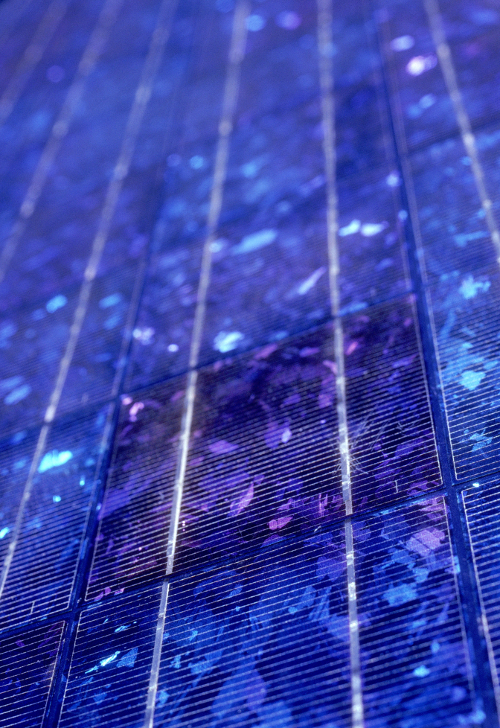Using AI to control energy for indoor agriculture
30 September 2024
Published online 5 January 2015
In a region with abundant sunlight, researchers are turning to an innovative technique to exploit its power: miniscule quantum dots or semiconducting crystals

Aram Amassian, a materials scientist and engineer at the King Abdullah University of Science and Technology (KAUST) in Thuwal, Saudi Arabia, speaks about the gap between the level of sunlight available and the amount of energy produced, “We are simply not converting as much sunlight as we could,” he says.
He explains that today’s best solar cells are built from semiconducting materials – usually silicon or copper indium gallium selenide – and typically lose upward of 80 per cent of the solar energy that strikes them. The materials used to make solar cells mainly absorb visible light. But in the Middle East and North Africa “we have a lot of light and heat in the infrared region of the spectrum that solar cells don’t absorb,” says Amassian.
That’s where quantum dots come in.
These semiconducting nanocrystals were first produced artificially in the mid-1980s and displayed intriguing features. For example, when shrunk to nanoscale, “the physical properties of these materials change from those that they usually exhibit in nature,” Amassian says. In particular, by changing the size of quantum dots, they can be tuned to absorb light at different wavelengths.
Multiple dots could, between them, cover the whole spectrum of visible light and the infra-red rays whose power had previously been wasted.
In the past decade, much work has been done on trying to incorporate quantum dots into solar cells to create a “rainbow solution that exploits the full broadband nature of sunlight,” says Edward Sargent, an electrical engineer and materials scientist at the University of Toronto (UofT) in Ontario, Canada. A big commercial advantage is that the dots are made from readily-available materials, such as germanium, which keeps manufacturing costs low.
The process for incorporating them into solar cells is also relatively cheap compared with current standard techniques. Currently, standard solar cells are made from expensive or rare materials in uncontaminated vacuum chambers –specialised and costly equipment. In contrast, quantum dots are suspended in a liquid that can be sprayed or coated in layers on to a thin film, without the need for a vacuum.
“They can be deposited as easily as the ink used to print newspapers,” says Amassian. “This is the real game-changer that makes quantum dots relevant for industrial applications.”
This marriage between nanotechnology and future-of-energy technologies is really vital to breaking the limit of how much energy we can get from cells.
But quantum dots are not quite ready to hit the mainstream. Standard silicon solar cells convert 15-20 per cent of incoming sunlight into usable power. The efficiency of solar energy conversion by cells based only on quantum dots lies at just 8 per cent – achieved earlier this year by Sargent, Amassian and others in an international research collaboration1. Before then, a major problem had been a loss of function by the dots when exposed to the air. The team overcame this by creating a protective film of iodine atoms for the dots, improving both stability and performance.
For the technology to become commercially competitive, this efficiency must be improved. Scientists around the world are looking for solutions by testing different materials for the quantum dots and methods for embedding them into films.
One problem is that the dots are often sprayed onto films randomly, which can leave gaps in the cell through which sunlight could pass without being captured.
In 2013 Professor Ammar Nayfeh and PhD student Amro Alkhatib, in the Department of Electrical Engineering at the Masdar Institute for Science and Technology in Abu Dhabi, demonstrated an inexpensive way to build a regular array of dots. They created a pattern of indentations on the surface of a silicon wafer, deposited a thin layer of germanium, and then allow the quantum dots to “self assemble” into those spaces2.
“It’s important to be able to place dots in a nice ordered way so that when selling to customers you can say exactly what the efficiency of the solar cell will be,” says Nayfeh.
Amassian is confident that performance will continue to improve. “The trajectory of quantum dot solar cells has been remarkable, improving at an annual rate just shy of one percentage point,” he says. The best strategy in the near-term may be to combine layers of quantum dots with existing standard silicon or thin film solar cells to capture some of the infra-red light that conventional cells lose, Amassian adds.
Nayfeh agrees that integrating quantum dots into existing silicon solar cell technology will be the easiest option in the short-term. “It is relatively simple to add quantum dots to standard cells to get more bang for the buck,” Nayfeh says, adding: “This marriage between nanotechnology and future-of-energy technologies is really vital to breaking the limit of how much energy we can get from cells.”
doi:10.1038/nmiddleeast.2015.3
Stay connected: